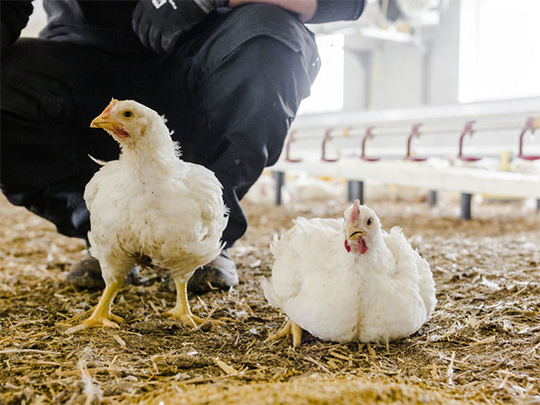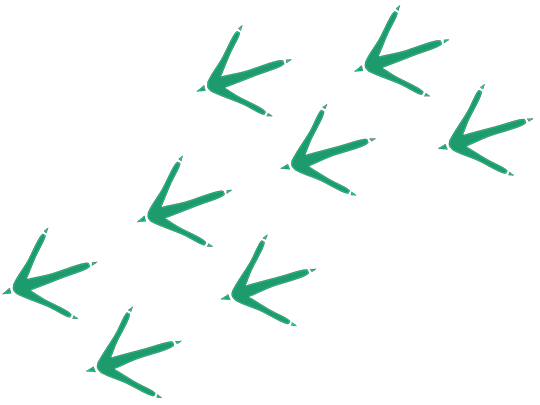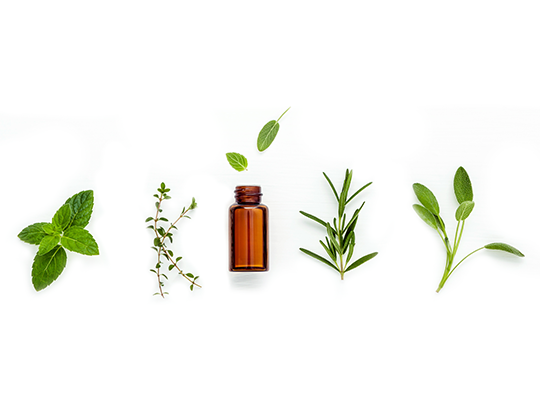Lameness in poultry?
A sudden rain shower, leaking shoes, and it’s already happened: The feet are wet inclusively the socks. You hear it too often as a child: Wet feet will make you sick. While wet feet often lead to colds in humans, they will increase the risk of footpad lesions in poultry. These affects both: animal performance and animal welfare.

Did you know? In several countries, footpad lesions in poultry is monitored as a welfare indicator. Moreover, chicken feet are exported to Asia for human consumption. Thus, a high occurrence of footpad lesions comes along with profit losses. But how do these lesions actually arise? When the callus softens due to prolonged exposition to moist litter, fine cracks in the epithelia arise, into which bacteria like Staphylococcus aureus may invade. In addition, ammonia irritates the upper layers of the skin and thus facilitate the occurrence of these necrotic lesions. In the further course the bacteria cause painful inflammation, deep ulcers, and swelling of the football. As one consequence, the animal changes its behavior and through the reduction of mobility, feed intake decreases. Lameness in poultry can lead to performance reduction. Slow healing of the inflammation leads to continuous contamination of the litter with bacteria and infections of other animals – a vicious cycle that needs to be breached.

The cause of this wet litter is a multi-factorial problem. But let’s not get ahead of ourselves:
Increased litter-moisture frequently raises from management problems, which subsequently affect animal stress, gut resilience and feed intake.
An adequate feeding strategy is crucial to maintain gut resilience in poultry and reduce litter moisture. Although modern feeding strategies, like pelleting increase nutrient density and improve feed intake – they simultaneously stimulate water intake. Due to increased feeding of highly concentrated diets, the water to feed ratio has increased in recent years. Any changes in nutrient supply have a strong impact on the excretion of water: an excess nutrient supply above needs increases the birds’ excretion, including those of water. Consequently, a balanced diet adjusted to the needs of the bird can help to improve litter quality.
While adjustments in housing and feeding strategies are relatively easy to handle, maintaining gut resilience - especially intestinal Integrity - requires special attention.
Maintained intestinal integrity is one of the key factors to decrease litter moisture and thereby to maintain normal health of the poultry feet. Did you know that intestinal integrity can also be influenced by feeding?
For example, a poor nutrient digestibility causes an increased accumulation and activity of microbes in the small intestine and the caecum. Moreover, the shift in caecal bacterial activity may result in impaired fat absorption, since certain microorganisms hydrolyze bile acids.
In addition, they may compete with the host organism for nutrients. Since microbial fermentation in the intestines supports the production of toxic metabolites, biogenic amines and irritating ammonia, which in turn attacks the intestinal wall – the so-called “leaky gut” syndrome may appear and as a result footpad lesions and lameness in poultry.
In this context, the intestinal integrity of the intestinal epithelium decreases, which can result in osmotic diarrhea and thus increased water excretion with the feces.
Did you know?
Depending on their chemical structure, essential oils can improve antioxidant capacity in two ways:
- Via the stimulation of endogenous antioxidant enzymes expression and synthesis or
- By direct scavenging of reactive oxygen species (ROS).
Since an excess of ROS may damage the intestinal epithelia, scavenging of these reactive molecules can contribute to a reduction of inflammatory processes in the intestine. Thus, reduced enterocyte turnover and improved intestinal integrity can be associated with a lower occurrence of the leaky-gut syndrome.
Not only wet litter can lead to lameness in poultry. In particular, excreted ammonia plays an additional significant role in the generation of footpad lesions due to its irritating effect on epithelia.
Ammonia, resulting from feed protein and amino acid degradation, is detoxified to uric acid in the liver of birds and then excreted via kidneys.
In the litter, the excreted uric acid is hydrolyzed to urea by the bacterial enzyme uricase. Subsequently, urea is further degraded by the bacterial enzyme urease. In this reaction ammonia is released. The converting bacteria require oxygen, heat and especially water to release ammonia.
But what can help to reduce ammonia emissions in poultry?
An alternative phytogenic strategy to suppress the activity of ammonia degrading bacteria, consists in the use of saponins:

Saponins, secondary plant metabolites from e.g. Quillaja saponaria bark, have the ability to reduce the formation of ammonia by direct binding of ammonia or inhibition of bacterial urease activity.
Thus, phytogenics can be a good tool in reducing ammonia emissions and maintaining resilience in poultry.
References available upon request

Anne Oberdorf
Anne has always been fascinated by the unknown, the diversity and beauty of nature. Her love for nature brought her to Delacon in 2018 after studying agricultural sciences, where she worked as Technical Communications Manager and later as Product Manager Aquaculture. Since February 2021, she has been taking a new, natural career path outside of Delacon.










